How to Get Rid of Poa Annua (Annual Bluegrass) In Your Lawn
A well-maintained lawn is the pride of any homeowner, providing a lush, green canvas for outdoor activities and enhancing the curb appeal of your property. However, achieving that perfect lawn can be a daunting task, especially when invasive weeds grasses like Poa annua, also known as annual bluegrass, make their presence known. In this guide, we will walk you through getting rid of Poa annua in your lawn, ensuring that your grass stays healthy and vibrant.
Annual bluegrass is a common and persistent grass-like weed that germinates between the late part of summer and the early part of fall. It often invades lawns, golf courses, and sports fields. While it might appear harmless at first, Poa annua can quickly take over your lawn, choking out desirable grasses and creating an ugly, uneven appearance.
The Importance of Proper Lawn Care
Maintaining a healthy lawn is not just about aesthetics; it has numerous benefits for both you and the environment. A well-kept lawn helps reduce soil erosion, filters pollutants, and provides a cooling effect for your property. Moreover, a healthy lawn offers a comfortable and attractive outdoor space for you and your family to enjoy. However, the presence of Poa annua can threaten the vitality of your lawn.
The Role of Warm-Season and Cool-Season Grasses
Understanding the distinction between warm-season and cool-season grasses is vital when dealing with Poa annua. Warm-season grasses, like Bermuda, Zoysia, and St. Augustine, thrive in hot summer climates, while cool-season grasses, such as Kentucky bluegrass and Perennial Ryegrass, do best in cooler climates. Poa annua is a cool-season grass, and it often competes with both warm and cool-season grasses for dominance in your lawn. Your grass type dictates available options for controlling Poa annua.
Identification and Characteristics of Annual Bluegrass
Before diving into the strategies for eliminating annual bluegrass from your lawn, it's essential to understand this invasive grass species thoroughly. Knowing the characteristics, growth patterns, and life cycle of Poa annua will help you make informed decisions when it comes to its control and removal.
Appearance: Poa annua typically has bright green, fine-textured leaves that form dense mats. If it has already established itself in your lawn, you will notice tall seed stalks with a distinctive tasseled appearance. The seed heads resemble small, branching structures, often described as looking like a miniature Christmas tree.
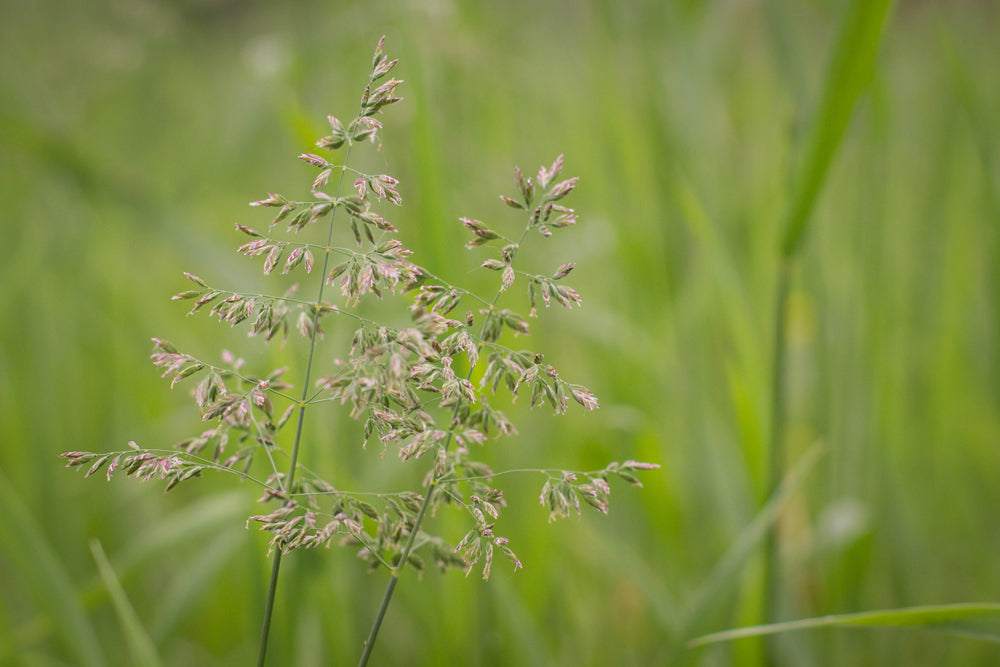
This weed grass exhibits a brighter shade of green compared to the rest of your lawn, and it may retain this vibrant green color even when the surrounding turf is dormant. However, in the summer, it tends to go brown when it dies in the heat. This transformation often results in bare patches in your lawn.
Growth habit: Annual bluegrass has a low-growing habit, usually reaching a height of three to eight inches. It prefers areas with excessive soil moisture and thrives in compacted soil. Compaction is detrimental to your turfgrass as it hinders the roots from accessing the necessary nutrients and water for optimal growth, so aerating your lawn at least once per year is important.
Seeding: Annual bluegrass reproduces primarily through seed production, which can result in a rapid and widespread infestation.
Leaf texture: The leaves are narrow and slightly folded, giving the grass a distinct appearance.
Germination: Poa annua seeds can germinate and establish quickly in the right conditions, making it a formidable competitor against desired grass varieties.
Why Poa Annua Is a Nuisance in Lawns
Poa annua is considered a nuisance in lawns for several reasons:
Competitive nature: This weed grass competes aggressively with desirable grasses for resources such as sunlight, water, and nutrients, often leading to a thinning and weakening of the desirable grass species.
Invasive growth: Annual bluegrass has a prolific seed production, contributing to its invasive nature. These seeds can quickly spread throughout your lawn and neighboring areas.
Inconsistent appearance: Due to its different growth habits, height, and appearance compared to your desired warm-season and cool-season grasses, Poa annua can create an unappealing and uneven lawn.
Seasonal variability: Poa annua tends to thrive during cool, wet seasons, and its growth can be especially noticeable during spring and fall when cool-season grasses are most active.
The Challenges Poa Annua Poses to Warm-Season and Cool-Season Grasses
Poa annua's presence can be particularly problematic for both warm-season and cool-season grasses, depending on the time of the year. These challenges include:
Competition: It competes with warm-season grasses during the spring to early summer months when these grasses are actively growing. This competition can result in patchy lawns.
It blends in: This is more likely if you have cool-season grass, making it much harder to selectively treat with herbicide without damaging your desired turfgrass.
Overseeding: Annual bluegrass can outcompete cool-season grasses during the fall and winter, leading to thin, unhealthy lawns and making overseeding necessary.
Disease susceptibility: Poa annua is more susceptible to certain diseases, such as dollar spot, rust, and snow mold, which can affect the overall health of your lawn.
How to Kill Poa Annua without Killing Grass
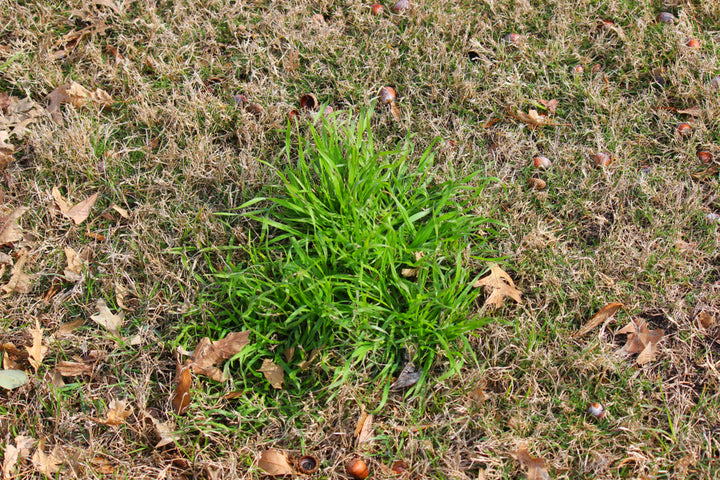
To effectively eliminate annual bluegrass from your lawn, a two-step approach is often necessary. Typically, you'll need to employ both post-emergent weed killers and pre-emergent lawn herbicides if you're committed to eradicating this persistent weed from your lawn.
The challenge with Poa annua lies in its tendency to recede and turn brown during hot temperatures. Sometimes, the issue might go unnoticed until those ugly brown patches appear or you find empty spaces within your lawn.
Another thing that makes it tricky to manage is its propensity to thrive in cooler weather, right when your turfgrass is less resilient. During this period, your turfgrass is often in a state of dormancy, leaving the soil more susceptible to weed growth, including annual bluegrass.
Using a post-emergent herbicide is a crucial step in increasing your likelihood of success in eliminating this resilient weed from your lawn. Unfortunately, there are very few selective post-emergent herbicides that work on annual bluegrass, especially for cool-season lawns.
Related: The Best Four Products for Killing Weeds Without Killing Grass
The Best Warm-Season Grass Post-Emergent Herbicides to Control Poa Annua
In the battle against Poa annua, having the right tools and products at your disposal is essential. Our first recommendation is Certainty herbicide — a powerful weapon in your arsenal when dealing with this invasive weed in lawns, particularly if you have warm-season grasses.
Certainty Herbicide is a selective herbicide designed to target and eliminate annual bluegrass while preserving the health and vitality of your warm-season grasses, such as Bermuda, Zoysia, and St. Augustine. It's an excellent choice for homeowners who want to maintain a lush and weed-free lawn without harming their desirable grass varieties.
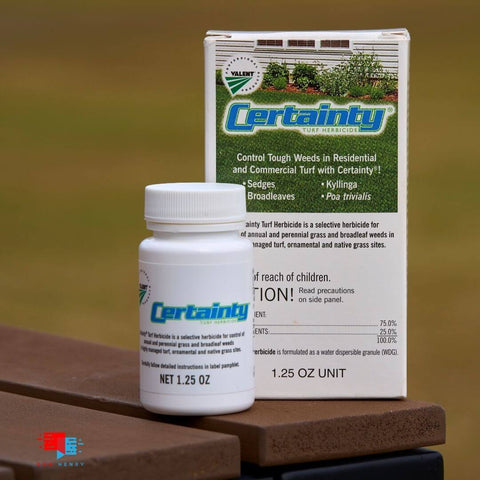
Keep in mind that Poa annua is categorized as a cool-season grass, sharing similarities with various cool-season turfgrasses like perennial ryegrass and Kentucky bluegrass.
For homeowners with a cool-season grass lawn, we do not recommend the application of post-emergent herbicides like Certainty. Such herbicides have the potential to damage, and, in some cases, even kill, your desirable grass varieties. This aspect must be carefully weighed when determining whether to use a post-emergent herbicide to target actively growing Poa annua.
How Certainty Herbicide Works to Eliminate Poa Annua
Certainty Herbicide works by inhibiting the growth of Poa annua at the cellular level. When applied according to the instructions, it selectively targets this weed while leaving your warm-season grasses unharmed. Here's how it achieves this:
Selective action: Certainty Herbicide is designed to affect the specific growth processes of Poa annua, making it an effective solution for warm-season grass lawns.
Growth inhibition: This herbicide disrupts the development of Poa annua, preventing it from thriving and ultimately causing it to wither and die.
Preservation of desirable grasses: Certainty Herbicide is formulated to have a minimal impact on warm-season grasses, allowing them to flourish and fill in the gaps left behind by the eliminated Poa annua.
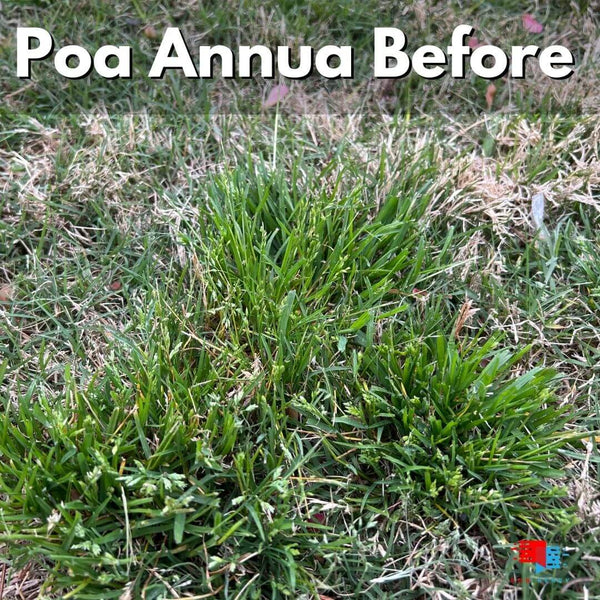
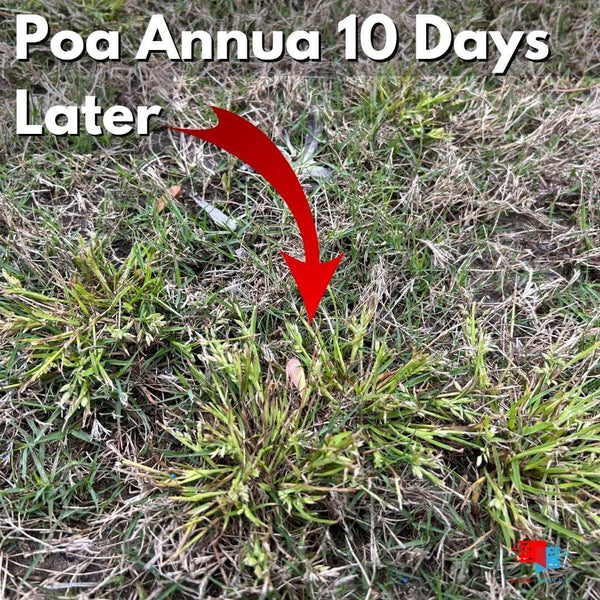
Application Guidelines and Safety Precautions
As with all herbicides, when applying Certainty, it's crucial to follow the application guidelines and safety precautions provided by the manufacturer. Some key points to keep in mind include:
Timing: Apply Certainty Herbicide during the recommended season for Poa annua control, which is early fall and early spring. The herbicide works best if applied when temperatures are between 55F-85F. It’s important that Poa annua is actively growing for best control...
Correct dosage: Measure and apply the correct dosage of Certainty Herbicide as per the label instructions. Using the proper amount ensures optimal effectiveness. The 1.25 oz. bottle covers up to 72,000 square feet. When controlling Poa, you’ll want to use a rate between 1.25 - 2.0 oz. per acre. A measuring spoon is included to simplify accurate and consistent application rates.
Application technique: Apply the herbicide evenly and consistently across your lawn, focusing on areas with annual bluegrass infestations. It is a professional formulation and should be applied from a battery-powered 4-gallon sprayer with a TeeJet foliar spray tip. This herbicide is not to be applied via a hose-end sprayer.
Use a non-ionic surfactant with Certainty for best results, as it helps the herbicide stick to the weeds better.
Safety gear: When applying herbicides, always wear the recommended safety gear, including gloves, protective clothing, and eye protection.
The Best Warm-Season Grass Pre-Emergent Herbicide
Preventing Poa annua from taking root and spreading in your lawn is a crucial step in maintaining a healthy, warm-season grass lawn. Specticle FLO, a warm-season grass pre-emergent herbicide, plays a pivotal role in this preventive approach.
Specticle FLO is a pre-emergent herbicide specially designed to inhibit the growth of weeds, including Poa annua, before they can establish themselves in your lawn. This herbicide offers an effective way to prevent the intrusion of invasive grasses and broadleaf weeds, ensuring that your warm-season grasses thrive.
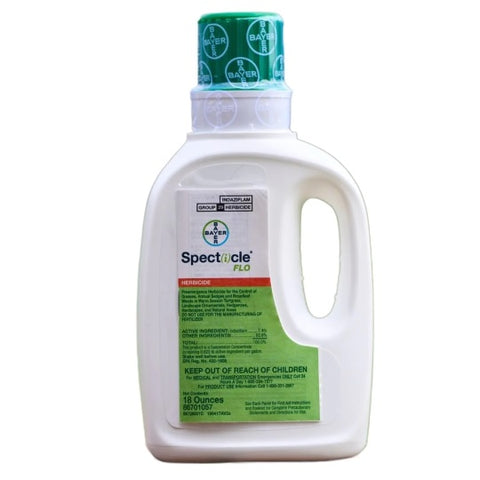
How Specticle FLO Prevents Poa Annua Growth
Specticle FLO forms a barrier in the soil, preventing weed seeds, including those of annual bluegrass, from germinating and growing. Here's how it accomplishes this:
Residual control: Specticle FLO provides long-lasting residual control, preventing weed seeds from developing into mature plants over 6 months.
Selective action: While effective against various weed species, Specticle FLO is selective and designed to minimize negative impact to warm-season grasses.
Preventive measure: By applying Specticle FLO before the growing season, you create a barrier that stops weed seeds from taking root, reducing the need for post-emergent weed control.
Application Timing and Instructions
Proper timing and application are crucial when using Specticle FLO. Follow these guidelines to ensure effective weed prevention:
Pre-emergent application: Apply Specticle FLO before weed seeds germinate in late summer or early fall. The timing of application is key and should align with the growing
season of your warm-season grasses. We recommend fall application when soil temperatures are in the low 70s trending cooler. This soil temperature map may help you work out when it is best to apply Specticle in your region. This herbicide does require watering in. Apply 1/4" of water from irrigation or rainfall to move Specticle FLO into the soil.
Proper dosage: Measure and apply the recommended dosage of Specticle FLO based on the size of your lawn and the targeted weed species. Our 18 oz. bottle covers 130,680 square feet. An application rate of .10-.20 fl oz. per 1000 square feet typically produces good results.
Uniform coverage: Ensure even and consistent application across your lawn to establish a continuous barrier against weed growth. A battery-powered 4-gallon sprayer with a large droplet nozzle is recommended.
The Best Cool-Season Grass Post-Emergent Herbicides to Control Poa Annua
Until recently, there wasn’t a good selective herbicide to control Poa annua in cool season lawns like Tall Fescue, Fine Fescue, Creeping Bentgrass, Perennial Ryegrass, and Kentucky Bluegrass. Our recommendation to control this troublesome weed in cool season lawns is Velocity PM herbicide.
Velocity PM (Poa Management) herbicide is an excellent broadleaf and grassy weed killer for cool-season turf. It takes care of difficult-to-control weeds like Poa annua, Poa trivialis, Clover, Yellow nutsedge, and many more.
It can be used on Tall Fescue, Fine Fescue, Creeping Bentgrass, Perennial Ryegrass, and Kentucky Bluegrass (limited cultivars). For Kentucky Bluegrass, you must test a small area to determine tolerance before blanket sprays.
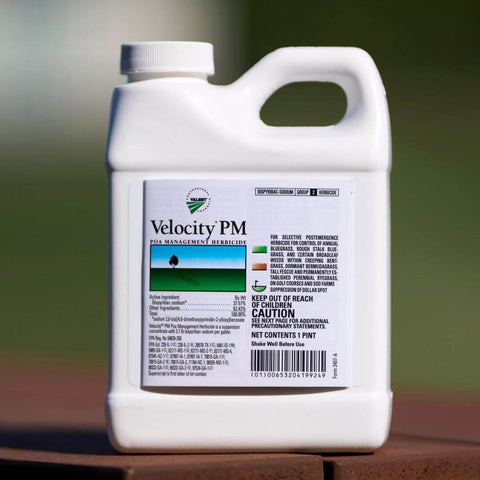
Application Timing and Instructions
This is a professional formulation and should be applied from Battery-powered 4 gallon sprayer with TeeJet foliar spray tip.
Velocity PM is most effective and safest when applied to turf and weeds that are actively growing. Treating when temperatures are consistently in the 70°s is a good time to start, but treatments can be more effective when air temperatures are in the 70°s and 80°s. Applications in the summer can be made when temperatures are up to 90° F.
The 16 oz. bottle of Velocity PM covers 7.1 acres (309,276 square feet).
Large Area Broadcast Application Rates: Apply 2.25 fl oz/A twice, 14 – 21 days apart. These two applications can be followed up with a third if warranted. To ensure thorough coverage, apply a minimum of 20 gallon of spray solution per acre.
Spot Treatments with a Backpack Sprayer Application Rates: Velocity PM has a very low-use-rate, requiring a small syringe for mixing exact measurements when using small spray tanks. The below recommendations are based on applications with a backpack sprayer that has been calibrated to deliver one (1) gallon of spray solution per 1000 square feet.
- Mix 1.5 ml (.05 fl oz) of Velocity PM for every gallon of water and apply over 1000 square feet.
- Spot treat Poa patches twice with the above mixture 14 - 21 days apart.
- Avoid any unnecessary sprayer overlap.
- Change the dilution rate accordingly if the backpack sprayer is calibrated to deliver anything different from one (1) gallon of spray solution per 1,000 sq ft.
It is NOT recommended to use surfactant of any kind with Velocity PM.
Cool-Season Grass Pre-Emergent Herbicide to Prevent Annual Bluegrass
Due to cost and limited options for post-emergent control, a preventative approach to controlling Poa annua is another effective strategy. For those who have cool-season grass lawns, prevent annual bluegrass intrusion using a pre-emergent herbicide like Prodiamine.
Prodiamine is a pre-emergent herbicide specifically formulated to inhibit the germination and establishment of weed seeds, including Poa annua. It is the generic version of Syngenta Barricade® 65 WDG herbicide and comes in a water-dispersable granule form (WDG). This herbicide is an essential component of a comprehensive strategy to maintain a healthy cool-season grass lawn free of invasive grasses and broadleaf weeds.
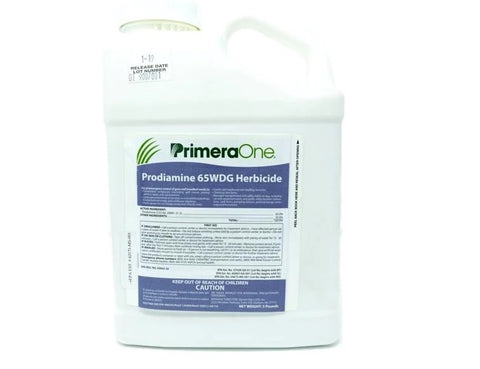
How Prodiamine Can Protect Cool-Season Grasses from Poa Annua Invasion
Prodiamine creates a protective barrier in the soil, preventing weed seeds from sprouting and developing into mature plants. Here's how it accomplishes this:
Preventive action: Prodiamine acts as a shield against Poa annua by stopping weed seeds from germinating and taking root in your lawn.
Selective nature: While effective against various weed species, Prodiamine is selective and designed to leave your desirable cool-season (and warm-season) grasses unharmed. If you have a lawn with a mix of cool and warm-season grasses, this is your best bet.
Long-lasting protection: When applied correctly, Prodiamine provides extended protection, reducing the need for frequent post-emergent weed control measures.
Proper Application Techniques and Considerations
To make the most of Prodiamine and ensure effective weed prevention, follow these essential guidelines for application:
Timing: Apply Prodiamine before the weed seeds have a chance to germinate. Early fall and early spring are the best times to apply pre-emergent herbicides to reduce weed pressure in your lawn. To control Poa annua, we recommend fall application when soil temperatures are in the low 70s, trending cooler. This soil temperature map may help you work out when it is best to apply Prodiamine in your region. In spring, apply Prodiamine when soil temps are in the high 40s, trending warmer, but before average soil temps are in the mid-50s.
Dosage: Measure and apply the recommended dosage of Prodiamine based on the size of your lawn and the targeted weed species. The 5 oz. bottle will cover up to 6,000 square feet of warm-season grass and 9,000 square feet of cool-season grass.
Even distribution: Ensure even and consistent application across your lawn to establish a continuous barrier against weed growth. A battery-powered 4-gallon sprayer with a large droplet nozzle is recommended.
Tips for a Lush and Thriving Lawn Year-Round
Achieving a thriving lawn year-round is the ultimate goal of any homeowner. Consider these additional tips to maintain your lawn's beauty and resilience:
Regular inspections: Regularly inspect your lawn for signs of Poa annua or other weed infestations. Prompt action can prevent issues from worsening.
Soil testing: Periodically test your soil to ensure it has the correct pH levels and nutrient content to support healthy grass growth.
Lawn Care Calendar: Create a lawn care calendar tailored to your specific grass type, including mowing, fertilization, and herbicide applications. Better still, use ours!
Achieving and maintaining a healthy, beautiful lawn requires dedication and effort, but the rewards are worth it. You'll have an outdoor space that you, your family, and your guests can enjoy year-round, whether for relaxation, entertaining, or gazing at proudly. So, roll up your sleeves and get ready to transform your lawn into a vibrant and welcoming haven.
Achieving a golf course lawn can be easier than you think. Check out our curated range of weedkillers and herbicides to help you tackle those pesky weeds.
J. Melvin
Apr 29, 2024
This is the BEST information I have found on this issue. It not only gives specific info on the weed, but best info ever on how to treat. We have Bermuda for our front lawn, but our backyard has always been problematic because of shading issues. Our lawn treatment service doesn’t cover our back lawn, which explains why this weed has almost taken over the yard. Additionally, our dogs are eating it – they look like a herd of cows out grazing! (Causing causing vomiting and diarrhea.) SO, this article has given this rookie lawn care person FANTASTIC info on what our next steps need to be. Thank you, thank you and THANK YOU AGAIN! I am bookmarking this site!! :-)